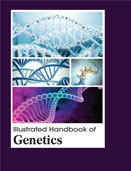Handbooks

This illustrated text provides a clear, balanced, and comprehensive introduction to genetics and genomics. Genetics is the study of heredity. Heredity is a biological process where a parent passes certain genes onto their children or offspring. Every child inherits genes from both of their biological parents and these genes in turn express specific traits. Some of these traits may be physical for example hair and eye color and skin color etc. On the other hand some genes may also carry the risk of certain diseases and disorders that may pass on from parents to their offspring. Humans have long observed that traits tend to be similar in families. It wasn?t until the mid-nineteenth century that larger implications of genetic inheritance began to be studied scientifically.
Genetics is the science of studying how living things pass on characteristics (or traits) and its variations in their cell make-up from one generation to the other. Genetics is not only important in humans. It also applies to plants and other living cells. A plant may pass on traits like number of fruits it bears, color of its? flowers or its? root structure via a seed, that will grow into a very identical plant. Genetic components can also modify the body?s response to environmental factors such as toxins. Understanding the underlying concepts of genetics and the role of genes, behavior, and the environment is important for appropriately collecting and applying genetic and genomic information and technologies.
Illustrated Handbook of Genetics provides the core concepts of how genes are structured and how they drive biological diversity. It also covers the nature of DNA and its relationship to the physical characteristics of organisms; the passage of DNA from organism to organism; and the variation of DNA within and across populations of organisms. Genetics apply to all forms of life, including plants, animals and humans. Humans have understood genetics on some level for thousands of years. They have been improving crops and animals through breeding for quite some time, selecting desirable traits and attempting to propagate them. Casual observations have also been an important part of human life for thousands of years, with people noting that members of certain families tend to have distinctive anatomical features. The Hapsburgs of Austria, for example, are famous for their prognathic jaws. Genetics is central to the development of the ideas presented in this book for three reasons. First, the exchange of genetic information between cells or organisms and the ability to recombine this DNA by cutting and splicing is widespread in nature. This means that these phenomena must confer high survival value and therefore are of great biological importance. Second, for many years genetics was at the center of research in molecular biology, first serving as an object of study and then as an aid to the study of the biochemistry of biological processes. Now genetics in the form of genetic engineering has become indispensable in the study of biological systems and in physical studies of systems. This book is suitable for students and researchers to foster an appreciation for the advances being made on all fronts of genetic research.